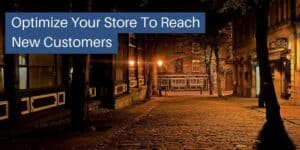Full-width images are a spectacular way to engage visitors to your website and immerse them in your content.
If you can immerse website visitors into your content then they’re more likely to stick around and engage with your content. Full-width images are the perfect way to engage because people are so visual.
If there’s anything visual about your business then images that make the business come to life are essential.
Full-screen images aren’t the only option, though. Images that span the width of the screen are also very helpful at immersing visitors and making specific items on a website stand out.
Images don’t only define your online presence (though that is an important factor) but they also help draw in visitors and convert them too.
There are reasons you need immersive images on your website beyond the fact that they look pretty. A good web designer will be able to translate your idea into a successful project that incorporate images well.
Why Would You Use Full-Width or Full-Screen Images?
Believe it or not that beautiful full-screen and full-width image does have a function if done right.
They can immediately explain to website visitors what you do in faster terms than even reading four words.
Personal Connection
Images can also help you make a personal connection with visitors. That’s especially important when you are your business and your face builds the relationship with people you do business with.
If you’re a musician for instance then aside from your music then your face is the most important part of your business. John Gruber is the face and center of John Gruber Music which is why his website makes sure he’s at the front and center of it all.
[bctt tweet=”You can use images to make a personal connection with website visitors.” username=”exprance”]
When people visit a website where a personal and trusting connection is important then a picture will do that best.
There’s something about full-screen images that really capture attention and make people want to browse around the website more. Check out this beach resort website with full-screen images. Don’t you want to browse around to see and learn more?
Calls To Action
Images are extremely important in website calls to action. Full-width or full-screen images are even more important because of the contrast they can draw and attention they grab.
Images can either draw attention or they can even guide attention to what you want people to look at.
Check out how this image can change how people interact with the copy on a landing page.
Looks like people are really preoccupied with the baby’s face. They’re so preoccupied with the baby’s face that they hardly get over to the important copy.
An easy way to fix that is understanding how our attention works. Few can resist looking at the face of a person on an image and we also want to see what the subject is looking.
One small fix and take a look:
That’s a huge improvement for just one minor change in where the baby is looking.
It doesn’t have to be that complex either.
Images can be used just to draw attention to a call to action also.

It’s a simple image that draws attention, sets the stage for the content, and makes the content stand out.
Those are just a few of the reasons to use full-screen or full-width images on your website. They’re good for business, simple.
Before you go throwing giant images everywhere though there are some considerations you have to keep in mind.
Important Considerations To Make
Before you jump too far into images for your website there are a few things to consider.
Your website is for business and each part of the website needs a purpose that is tied to your business. Without a purpose then you risk overloading your website with large images that take a long time to load and serve no purpose but to distract.
Images if not done right can easily slow down your website for visitors but they can also become distracting if not used carefully and with purpose.
Full-width images are great for calls to action and drawing attention to certain information. If they’re not used for that then what is their purpose?
[bctt tweet=”Images on your website for decoration or to look pretty is a trap.” username=”exprance”]
It’s easy to start distracting with superfluous images that serve no functional purpose other than to look pretty.
Looking pretty is a trap though.
Before looks or design trends should come function for the business.
Is the website going to convert visitors into leads and is it providing something useful to visitors.
If the answer is no, do away with the image. You’re better off without an image than with one that serves no functional purpose.
Everything in your business should be with purpose including your website content.
There are some technical things to keep in mind when going for the full-width or full-screen images.
The first thing to look at is the dimension.
The Ideal Dimension For Full-Width Images
The dimension of full-width images for your website isn’t something that can easily be defined.
I found a lot of recommendations but it really all comes down to knowing your audience and how people will access your website.
If your audience is primarily on mobile phones then the file size of images are more important than the resolution.
Recommendations for image dimensions span from 1250 pixels wide all the way to 1920 pixels.
In most cases, 1920 pixels isn’t necessary though. The files size gets too large and speed isn’t something you want to sacrifice for a business.
For desktops large display sizes are popular but smaller images sizes will stretch to fit and not lose much quality in many cases.
There are also mobile devices to account for now though. For many websites especially in the consumer world, mobile devices are the most used.
If mobile devices are what your audience is using file size matters more than image dimensions.
1920 pixels is the most common recommended width for full-width images but not necessarily right for you.
What Others Are Using
Every website is unique and they use different dimensions based on their needs.
To get a better idea for you, though, it’s helpful to look at what others are doing.
So, here are some different sizes according to Malama:
- 1400 x 875 –1.6 ratio– Patagonia
- 1920 x 1080 –1.78 ratio– General Motors
- 1920 x 1165 –1.65 ratio– Zara Clothing
- 2560 x 1707 –1.5 ratio– Burberry
- 1440 wide — Adidas
- 1600 wide — Nike
- 1800 wide — Burger King
I do use different dimensions than these in many cases, though, depending on how the image looks. I don’t stick with a hard 1920.
Sometimes I use 1250 pixels as recommended as the minimum for Wix websites (they are just websites after-all) but other times 1600 is an ideal width.
These are all assuming an image dpi of 72 so keep that in mind when creating images that will immerse website visitors.
It’s all about a balance between the dimension and file size.
Balancing Dimension With File Size
The size of your website has a huge impact on how fast your website loads. Only the host has a comparable impact on speed.
Keeping the file sizes on your website down is essential to a fast website that doesn’t lose visitors. People do leave if your site doesn’t load fast.
Whatever dimension you settle on for any given full-width image on your website, the size of the image should be accounted for also.
No single page of your website should be too large.
Just as balancing the goal of each page with the speed, the image should be balanced with the goal also.
With all of this, it does all come down to drawing visitors in knowing they’ll leave if it takes too long or is boring. A balancing act really.
What It All Comes Down To
Your website is there for a reason, to help you grow your business.
Anything that can help lead to business growth from your website is important.
A website should have large immersive images that draw visitors in. It helps tell the story and lead visitors towards the call to action.
If you’re not taking advantage of the opportunities immersive images can provide for converting visitors into leads it’s time to do so.
A web designer can help you take the right approach to a good website that’s built with purpose and quality.






